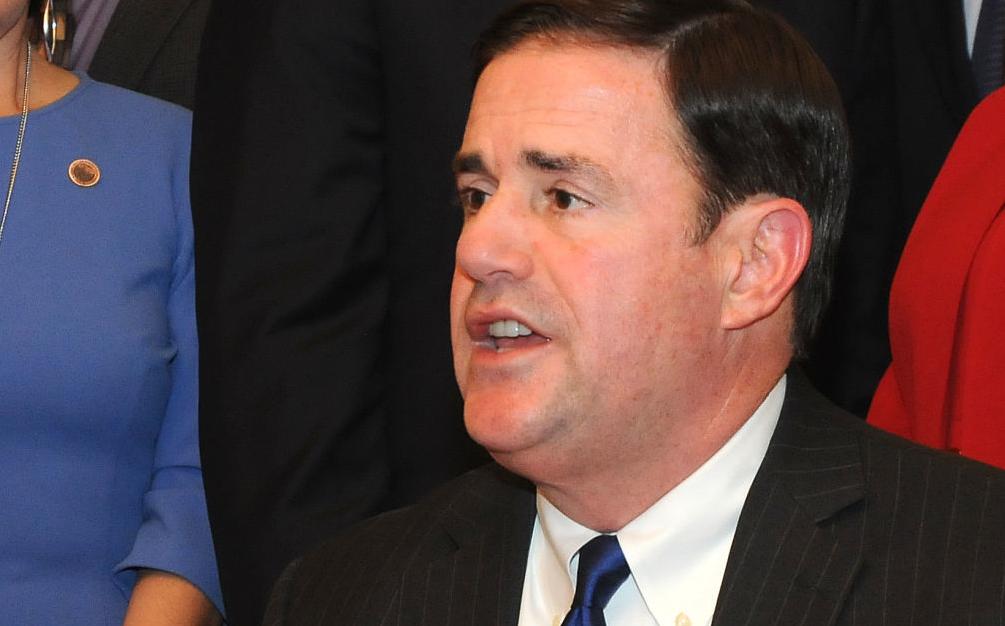TEMPE — Gov. Doug Ducey denied Tuesday that he unilaterally ordered the Commerce Authority to rescind a $1 million incentive that had been offered to Nike to locate a manufacturing facility in Goodyear.
The offer disappeared after a series of early-morning Twitter posts July 2 in which Ducey said he was upset about the decision by the company to cancel the rollout of a new sneaker that featured the Betsy Ross flag. The move by Nike apparently followed concerns that that the flag would remind blacks that it flew during a period when slavery was legal.
But the governor insisted he never ordered the state authority to withhold the money.
“I’d direct you to re-read the tweet,” he said.
The tweet, however, does not back the governor’s contention.
“Nike has made its decision, and now we’re making ours,” he wrote at the time. “I’ve ordered the Arizona Commerce Authority to withdraw all financial incentive dollars under their discretion that the state was providing for the company to locate here.”
On Tuesday, Ducey defended the move. But the governor did not explain how he, as one member of the Commerce Authority, had the legal ability to rescind the grant, offering at time conflicting explanations.
“The Commerce Authority did not vote for the incentive,” he said.
Yet Ducey also claimed he actually had the backing of the agency’s public-private board.
“Sometimes boards agree with me, sometimes they don’t,” he said. “In this instance, they did, they agreed with me.”
But there is no evidence the board actually met to discuss the Nike incentive before or after Ducey sent out the 2 a.m. tweets.
The governor sidestepped a question of whether, in future incentive offers, he would have to approve the company’s politics before it could qualify for a state incentive.
“I sit on the Arizona Commerce Authority,” he responded.
“These are subjective decisions,” Ducey said. “And I’ve made my decisions.”
That led to a question of whether it was proper for the Commerce Authority, on which Ducey sits, to simply accede to his directive to withdraw the incentive.
“Well, the Commerce Authority is working very well,” the governor responded.
Ducey’s comments came after he attended a news conference where technology giant Microsoft provided some details Tuesday about the three new data centers it plans to open in west Phoenix suburbs.
Brian Janous, the company’s manager of energy and sustainability, said the new facilities in El Mirage and Goodyear will not be the drain on power and water that has historically been an issue with these kinds of facilities.
He said they will be powered 100 percent with renewable energy. That includes a partnership with Arizona-based First Solar to supply power to build a new 150-megawatt solar plant to be built in Maricopa.
Janous also said the operations are designed to not use any water for cooling until the temperature hits 85 degrees. Even then, he said, Microsoft plans to use “evaporative” technology which is more efficient than other water-based cooling.
And Janous said Microsoft is investing in a water-conservation project he said will help sustain water levels in Lake Mead. That, in turn, will help Arizona avoid having to further curtail how much water it can take from the Colorado River in future years.
Microsoft had previously announced it had purchased the sites with the intent of providing new locations for the increasing need for cloud storage of data.
What the company disclosed Tuesday was that the project will create about 100 permanent jobs when fully operational and a $20 million annual economic impact. It also involves about 1,000 construction jobs.
One financial benefit for Microsoft in locating in Arizona is that it qualifies as what the Arizona Commerce Authority calls a “sustainable redevelopment project computer data center.” What that means is that it does not have to pay sales and use taxes on the purchase of qualifying computer equipment delivered to and installed at the facility.
Authority spokeswoman Connie Weber said the incentive requires Microsoft to make a minimum $200 million investment. She said it also has to be certified as a “green” building within the next five years.





